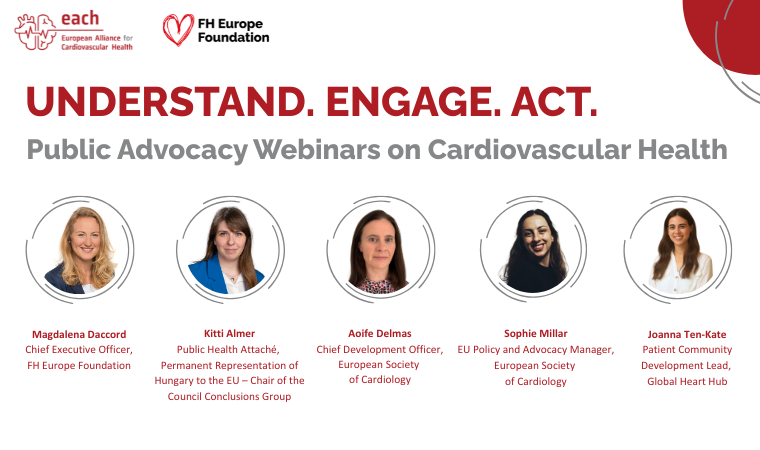
In May and June 2025, the FH Europe Foundation, on behalf of the European Alliance for Cardiovascular Health (EACH), hosted two editions of the same public advocacy webinar. The decision to run the session on separate dates was driven by a desire to ensure maximum accessibility for a wide range of stakeholders across Europe and beyond. Partners of EACH were invited to join as panellists.
The webinars aimed to raise awareness and support meaningful engagement with the EU Council Conclusions on Cardiovascular Health, formally adopted in December 2024. This historic document represents the first EU-level political commitment to cardiovascular health in over two decades. As such, it offers a vital opportunity for patients, civil society organisations, healthcare professionals, and policymakers to align on a shared agenda for prevention, equity, and long-term impact.
Each webinar brought together a distinguished panel of speakers, including:
Throughout the session, the panel examined the burden of cardiovascular disease (CVD), which remains the leading cause of death in Europe, and explored the urgency of renewed political attention. The Council Conclusions were presented as a vital non-legislative yet politically significant agreement, unanimously adopted by EU Member States, that can serve as both a strategic reference and an advocacy tool.
The scope of the Conclusions was explained through a comprehensive life-course approach, focusing on health promotion, prevention, screening, treatment, rehabilitation, and innovation. Attention was also given to addressing persistent inequalities—whether between regions, genders, or socio-economic groups.
Kitti Almer, who chaired the drafting group, explained the document in a very simple and accessible fashion, condensing a complex document of 26 pages into a 10 min presentation. The Conclusions represent a comprehensive, life-course approach to improving cardiovascular health, structured around five pillars:
They also emphasise equity, addressing disparities across regions, genders, and socio-economic groups. The Conclusions formally recognize deep inequalities in care between and within countries, significant gender disparities, with women often underdiagnosed and undertreated, the economic burden of CVDs, costing the EU billions annually and persistent behavioural and environmental risk factors like smoking, diet, inactivity, and pollution.
The Conclusions include clear invitations to the European Commission and to EU Member States as follows:
To the European Commission:
To EU Member States:
But there is also a huge role for civil Societies like patient organisations to play. As Joanna Ten-Kate emphasised, civil society has a unique opportunity to turn these high-level policy agreements into action:
Speakers emphasised the importance of practical advocacy, offering guidance for how organisations and individuals can use the Conclusions to support national campaigns, seek funding, and influence policymaking. Concrete examples were shared, including patient-led outreach to national finance ministries, as presented by GHH and FHEF, to ensure dedicated EU funding for cardiovascular strategies is included in the upcoming budget cycle.
Across both sessions, the webinars welcomed 126 unique participants from 34 countries, with a total of 275 registrations. The audience comprised patient leaders, national advocates, health professionals, EU health policy observers, and nonprofit representatives. Many attendees were motivated by a desire to better understand the Council Conclusions, acquire practical tools for engagement, and join a coordinated effort for cardiovascular health equity across Europe.
During the concluding poll, 73% of respondents reported that the webinar had increased their understanding of the Council Conclusions and strengthened their confidence to take action. The remaining participants indicated that the follow-up actions were not applicable to their role or region—highlighting the diversity of the audience and the need for ongoing, localised support.
The EU Council Conclusions on Cardiovascular Health represent a rare alignment of political commitment, patient advocacy, and scientific consensus. But they are only the beginning. To ensure that this policy momentum translates into real outcomes, civil society must continue to push for national implementation, strategic investment, and cross-border collaboration.
Read some of the important resources shared during the webinar:
Watch the webinar recordings:
What is next?
The work on the European Union Cardiovascular Health Plan (EU CVH Plan) is advancing a lot faster than we could have expected. Therefore, we ask now for your immediate support and action at this critical phase.
Thanks to years of collective advocacy led by the European Alliance for Cardiovascular Health (EACH), the EU has made a historic commitment to addressing cardiovascular diseases. The Council Conclusions adopted in December 2024 and the Commissioner’s announcement of a dedicated CVH Plan mark a major step forward.
The process is now underway, moving faster than expected. This is excellent news — but it also creates a narrow and urgent window to ensure that the plan is backed by the necessary EU funding.
Read the Briefing on the EU policy context here
Why Your Action Matters Now
The success of the CVH Plan depends on securing dedicated, multi-year EU funding, to be decided in the upcoming EU budget cycle. With the European Commission expected to release its initial proposal as early as July, action is needed in the coming weeks.
What You Can Do:
Need help adapting the letter or planning your outreach? We’re here to support you — contact us at info@fheurope.org.